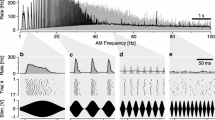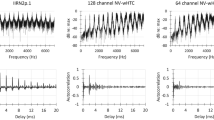Summary
-
1.
The large posterior tympanic membrane in intact field crickets vibrates up to several hundred. Angstroms in response to sounds of the same frequency and intensity as the cricket's calling song. The mechanical response is linear (Fig. 3), shows a peak near 5kHz (Figs. 2, 5), and the membrane vibrates in the same simple mode in response to tones from 4 to 20kHz (Fig. 4).
-
2.
Reducing the movement of the large tympanic membrane by covering it with vaseline or by tearing holes in it (Fig. 7) causes a corresponding decrease in sensitivity of auditory interneurons (Figs. 6, 8).
-
3.
The measured vibration of the small tympanic membrane is of the same order of magnitude as that of the cuticle adjacent to the membrane and it shows no selective tuning.
-
4.
Introducing helium into the leg trachea changes the sensitivity of auditory interneurons. Thresholds near 5kHz increase by up to 30 dB and thresholds near 18kHz decrease by up to 13 dB (Fig. 9). This shift in tuning of the organ appears to be due to a change in the resonant frequency of the leg trachea.
-
5.
Acoustical calculations are consistent with our conclusion that the dominant tuning of the large tympanic membrane and of the organ to 5 kHz is due to a tracheal resonance.
Similar content being viewed by others
References
Adams, W. B.: Mechanical tuning of the acoustic receptor ofProdenia eridania (Cramer) (Noctuidae). J. exp. Biol.57, 297–304 (1972)
Bekesy, G.V.: Experiments in hearing (ed. E.G. Wever). New York: McGraw Hill 1960
Bentley, D. R.: Intracellular activity in cricket neurons during generation of song patterns. Z. vergl. Physiol.62, 267–283 (1969)
Bentley, D., Hoy, R.R.: The neurobiology of cricket song. Sci. Amer.230, 33–44 (1974)
Dragsten, P. R., Webb, W. W., Paton, J. A., Capranica, R. R.: Auditory membrane vibrations: Measurements at sub-Ångström levels by optical heterodyne spectroscopy. Science185, 55–57 (1974)
Dragsten, P. R., Webb, W.W., Paton, J. A., Capranica, R. R.: Light scattering heterodyne interferometer for vibration measurements in auditory organs. J. acoust. Soc. Amer.60, 665–671 (1976)
Fielden, A.: Transmission through the last abdominal ganglion of the dragonfly nymph,Anax imperator. J. exp. Biol.37, 832–844 (1960)
Gesteland, R.C., Howland, B., Lettvin, J. Y., Pitts, W. H.: Comments on microelectrodes. Proc. IRE47, 1856–1862 (1959)
Hill, K. G.: Carrier frequency as a factor in phonotactic behavior of female crickets (Teleogryllus commodus). J. comp. Physiol.93, 7–18 (1974)
Hill, K., Boyan, G.S.: Directional hearing in crickets. Nature262, 390–391 (1976)
Johnstone, B. M., Saunders, J. C., Johnstone, J. R.: Tympanic membrane response in the cricket. Nature227, 625–626 (1970)
Kinsler, L. E., Frey, A. R.: Fundamentals of acoustics. New York: John Wiley 1962
Lewis, D. B.: The physiology of the tettigoniid ear. I. The implications of the anatomy of the ear to its function in sound reception. II. The response characteristic of the ear to differential inputs: Lesion and blocking experiments. III. The response characteristic of the intact ear and some biophysical considerations, IV. A new hypothesis for acoustic orientation behavior. J. exp. Biol.60, 821–869 (1974)
Loftus-Hills, J. J., Littlejohn, M.J., Hill, K. G.: Auditory sensitivity of the cricketsTeleogryllus commodus andT. oceaniens. Nature (New Biology)233, 184–185 (1971)
Merrill, E.G., Ainsworth, A.: Glass-coated platinum-plated tungsten microelectrodes. Med. Biol. Eng.10, 662–672 (1972)
Michelsen, A.: The physiology of the locust ear. II. Frequency discrimination based upon resonances in the tympanum. Z. vergl. Physiol.71, 63–101 (1971)
Miller, P.L.: Respiration in the desert locust. II. Control of the spiracles. J. exp. Biol.37, 224–236 (1960)
Morse, P. M.: Vibration and sound. New York: McGraw-Hill 1948
Morse, P. M., Ingard, K.U.: Theoretical acoustics. New York: McGraw-Hill 1970
Nocke, H.: Physiological aspects of sound communication in crickets (Gryllus campestris L.). J. comp. Physiol.80, 141–162 (1972)
Nocke, H.: The tympanal trachea as an integral part of the ear inAcripeza reticulata Guerin (Orthoptera, Tettigonioidae). Z. Naturforsch.29c, 652–654 (1974)
Nocke, H.: Physical and physiological properties of the tettigoniid (grasshopper) ear. J. comp. Physiol.100, 25–57 (1975)
Paton, J. A.: Frequency analysis in the auditory system of field crickets. Ph. D. Thesis, Cornell University, Ithaca, New York 1975
Popov, A. V., Shuvalov, V. F.: The spectrum, intensity, and direction of the calling song of the cricketGryllus campestris under natural conditions. J. Evol. Biochem. Fiziol.10, 72–80 (1974)
Roeder, K. D.: Interneurons of the thoracic nerve cord activated by tympanic nerve fibers in noctuid moths. J. Insect Physiol.12, 1227–1244 (1966)
Stout, J. F., Huber, F.: Responses of central auditory neurons of female crickets (Gryllus campestris L.) to the calling song of the male. Z. vergl. Physiol.76, 302–313 (1972)
Wever, E. G., Vernon, J. A.: The auditory sensitivity of Orthoptera. Proc. Nat. Acad. Sci. USA45, 413–419 (1959)
Whittaker, E.T., Watson, G.H.: A course of modern analysis, 4th ed. Cambridge: Cambridge University Press 1927
Young, D., Ball, E.: Structure and development of the auditory system in the prothoracic leg of the cricketTeleogryllus commodus (Walker). I. Adult structure. Z. Zellforsch.147, 293–312 (1974)
Author information
Authors and Affiliations
Rights and permissions
About this article
Cite this article
Paton, J.A., Capranica, R.R., Dragsten, P.R. et al. Physical basis for auditory frequency analysis in field crickets (Gryllidae). J. Comp. Physiol. 119, 221–240 (1977). https://doi.org/10.1007/BF00656635
Received:
Issue Date:
DOI: https://doi.org/10.1007/BF00656635




